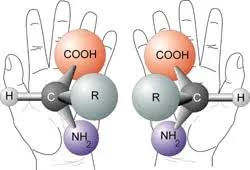In a range of phenomena and at vastly different scales, nature often seems to prefer one handedness over another, Felser adds. This is reflected in the fact that matter predominates over antimatter in the Universe, and that life uses left-handed amino acids and right-handed sugars.
The asymmetry in life functionally important. Without uniform
L-amino acids, proteins would be unable to fold and function. Living cells have quality control systems to ensure that no wrong-handed building blocks get into the molecules needed for life. Another article on Phys.org says that the health disaster of birth defects from the use of thalidomide came about because the drug was a mixture of both hands; “it turned out that while one was effective, its mirror image counterpart was toxic.”In a vastly different but related sense, the matter vs antimatter asymmetry is functionally important. Equal amounts of both would lead to collisions that would annihilate all matter in random bursts of deadly energy. If no matter, then no stars, no planets, no life.
The importance of molecular asymmetry is well established, but its origin is a mystery to believers in chemical evolution. Life needs single-handed building blocks, but unguided nature could not have provided them. Any naturally-produced building blocks would have been 50/50 blends of both hands, or racemic mixtures. Even if one could imagine a pure one-handed starting pool, they would racemize over time.
Before a working cell could ever form with the quality control to build uniformly-handed proteins, only mixed-handed polymers would be able to form in a chemical soup. Such a time before life, furthermore, would be unable to conjure up a success with natural selection, given that natural selection—if it even worked—requires accurate replication. That, in turn, requires a genetic code with quality control, proteins and enzymes, and a sophisticated membrane to hold everything together.
It is unthinkable to imagine all these requirements being met by chance when even one small protein defies the probabilistic odds by many, many orders of magnitude." CEH

